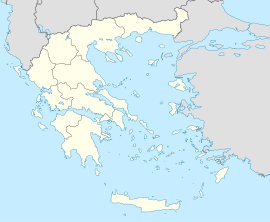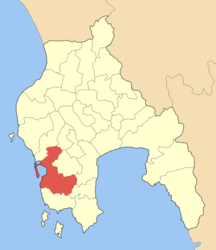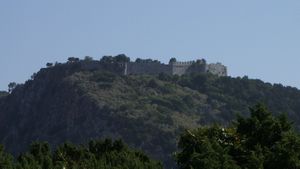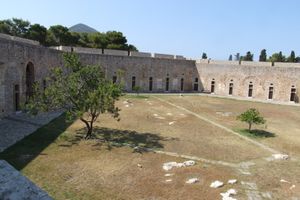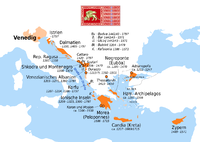پيلوس
Pylos
Πύλος | |
|---|---|
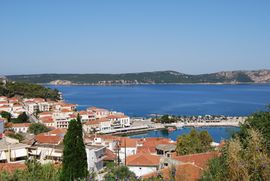 The bay of Pylos. | |
| الإحداثيات: 36°55′N 21°42′E / 36.917°N 21.700°E | |
| البلد | |
| المنطقة الادارية | المورة |
| الوحدة المحلية | مسنيا |
| البلدية | پيلوس-نستوراس |
| • الوحدة البلدية | 143٫91 كم² (55٫56 ميل²) |
| المنسوب | 3 m (10 ft) |
| التعداد (2011)[1] | |
| • الوحدة البلدية | 5٬287 |
| • كثافة الوحدة البلدية | 37/km2 (95/sq mi) |
| منطقة التوقيت | UTC+2 (EET) |
| • الصيف (التوقيت الصيفي) | UTC+3 (EEST) |
| Postal code | 240 01 |
| مفتاح الهاتف | 27230 |
| Vehicle registration | KM |
پيلوس (باليونانية: Πύλος)، وكانت تُعرف تاريخياً بإسمها الإيطالي نڤارينو Navarino، هي بلدية سابقة في مسنيا بمنطقة المورة في اليونان. يبلغ عدد سكانها حوالي 1902 نسمة.
التاريخ
پيلوس قبل التاريخ والميسينية
تضم پيلوس أدلة على استيطان بشري مستمر بها منذ العصر الحجري الحديث. في الأزمنة الميسينية، كانت مركزاً هاماً، فمملكة نستور في "پيلوس الرملية"، كما يذكرها هومر في السفر 17 من الأوديسة:
We left for Pylos, Nestor too
the shepherd of the peoples,
And He, receiving me the king,
within his halls so lofty,
Embraced me with all
eagerness as father does
his youngling
His son back from long time abroad.
هومر، الأوديسة
XVII 108-112
دولة پيلوس الميسينية (1600–1100 ق.م.) امتدت على مساحة قدرها 2000 كيلومتر مربع بعدد سكان لا يقل عن 50,000 نسمة حسب ألواح مكتوبة بخط Linear B، أو ربما بلغ 80,000 - 120,000.[2][3]
العصور الوسطى
Little is known of Pylos under Byzantine rule, except for a mention of raids by Cretan Saracens in the area c. 872/3.[4] In the 12th century, the Muslim geographer al-Idrisi mentioned it as the "commodious port" of Irūda in his Nuzhat al-Mushtaq.[4]
الفترتان البندقية الأولى والعثمانية الأولى
In 1423, Navarino, like the rest of the Peloponnese, suffered its first Ottoman raid, led by Turakhan Bey, which was repeated in 1452.[5] It was also at Navarino that Emperor John VIII Palaiologos embarked in 1437, heading for the Council of Ferrara, and where the last Despot of the Morea, Thomas Palaiologos, embarked with his family in 1460, following the Ottoman conquest of the Despotate of the Morea.[5] After 1460, the fortress, along with the other Venetian outposts and Monemvasia and the Mani Peninsula, were the only Christian-held areas in the peninsula.[5][4] Venetian control over Navarino survived the First Ottoman–Venetian War (1463–79), but not the Second (1499–1503): following the Venetian defeat in the Battle of Modon in 1500, the 3,000-strong garrison surrendered, although it was well provisioned for a siege. The Venetians nevertheless recaptured it shortly after, on 3/4 December, but on 20 May 1501, a joint Ottoman land and sea attack under Kemal Reis and Hadım Ali Pasha retook it.[5][4]
The Ottomans used Navarino (which they called Anavarin or Avarna) as a naval base, either for piratical raids or for major fleet operations in the Ionian and Adriatic seas.[4] In 1572/3, the Ottoman chief admiral (Kapudan Pasha) Uluç Ali Reis built a new fortress at Navarino (Anavarin-i Cedid, "New Navarino", or Neokastro in Greek), to replace the outdated Frankish castle.[4]
The Venetians briefly captured Navarino in the 1650s during the Cretan War.[4]
في 1668، وصف أوليا چلبي المدينة في كتابه سياحتنامه:
Anavarin-i Atik is an unequalled castle... the harbor is a safe anchorage...
in most streets of Anavarin-i Cedid there are many fountains of running water... The city is embellished with trees and vines so that the sun does not beat into the fine marketplace at all, and all the city notables sit here, playing backgammon, chess, various kinds of draughts, and other board games....
الفترة البندقية الثانية واستعادة العثمانيين لها حتى استقلال اليونان
التقسيمات الادارية
The municipal unit Pylos is subdivided into the following communities:
- Ampelokipoi
- Chomatada
- Gialova
- Glyfada
- Iklaina
- Kallithea
- Kynigos
- Mesochori
- Pappoulia
- Pidasos
- Pyla
- Pylos
تطور التعداد
| Year | Town population | Municipality population |
|---|---|---|
| 1981 | 2,594 | - |
| 1991 | 2,014 | 5,340 |
| 2001 | 2,104 | 5,402 |
| 2011 | 2,767 | 5,287 |
انظر أيضاً
- Enkheljāwōn, a person whom modern scholars regard as a possible king of Mycenaean Pylos
- List of settlements in Messenia
الهامش
- ^ أ ب "Απογραφή Πληθυσμού - Κατοικιών 2011. ΜΟΝΙΜΟΣ Πληθυσμός" (in اليونانية). Hellenic Statistical Authority.
- ^ Schwartz, G.M.; Nichols, J.J. (2010). After Collapse: The Regeneration of Complex Societies. University of Arizona Press. p. 80. ISBN 9780816529360. Retrieved 2014-12-07.
- ^ Wachsmann, S.; Bass, G.F. (2008). Seagoing Ships and Seamanship in the Bronze Age Levant. Texas A&M University Press. p. 359. ISBN 9781603440806. Retrieved 2014-12-07.
- ^ أ ب ت ث ج ح خ Bées, N.; Savvides, A. (1993). "Navarino". The Encyclopedia of Islam, New Edition, Volume VII: Mif–Naz. Leiden and New York: BRILL. pp. 1037–1039. ISBN 90-04-09419-9.
- ^ أ ب ت ث خطأ استشهاد: وسم
<ref>غير صحيح؛ لا نص تم توفيره للمراجع المسماةSavvides2
مراجع
- John Bennet, Jack L. Davis, Fariba Zarinebaf-Shahr, "Pylos Regional Archaeological Project, Part III: Sir William Gell's Itinerary in the Pylia and Regional Landscapes in the Morea in the Second Ottoman Period", Hesperia 69:3:343-380 (July–September 2000) at JSTOR
- Fariba Zarinebaf, John Bennet, and Jack L. Davis, A Historical and Economic Geography of Ottoman Greece: The Southwestern Morea in the 18th century, Hesperia Supplement 34, Princeton, 2005. ISBN 0-87661-534-5. A study combining archaeological and survey results with information from the Ottoman archives.
- Diana Gilliland Wright, book review of Zarinebaf et al., Electronic Journal of Oriental Studies 8:10:1-16 (2005). A very complete summary of Zarinebaf. PDF.
- Jack L. Davis (ed.), Sandy Pylos. An Archaeological History from Nestor to Navarino. Second edition. Princeton, NJ: ASCSA Publications, 2008. Pp. lix, 342; figs. 135.
وصلات خارجية
- Official site for Pylos (in Greek)
- Pylos Regional Archaeological Project (PRAP) – University of Cincinnati
- PRAP: Tour of Hall 64 and its Environs – QuickTime reconstruction and tour of Hall 64 and surroundings
- Perseus on Pylos
- The Pylos Project – University of Minnesota
- Pylos (Epano Englianos) – Metis QTVR collection of QT panoramas relating to the site
- Παλαιό Ναυαρίνο (Old Navarino), Greek Ministry of Culture (باليونانية)
- Νιόκαστρο (New Navarino), Greek Ministry of Culture (باليونانية)
- Pages using gadget WikiMiniAtlas
- CS1 اليونانية-language sources (el)
- Short description is different from Wikidata
- Coordinates on Wikidata
- Articles containing Greek-language text
- Pylos
- Cities in ancient Peloponnese
- Archaeological sites in the Peloponnese (region)
- Bronze Age palaces in Greece
- موانئ على البحر المتوسط في اليونان
- Mycenaean sites in the Peloponnese (region)
- مقالات تحتوي مقاطع ڤيديو
- مدن اليونان

